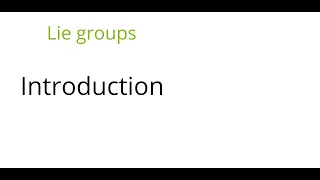Lie groups | Manifolds | Symmetry
Lie group
In mathematics, a Lie group (pronounced /liː/ LEE) is a group that is also a differentiable manifold. A manifold is a space that locally resembles Euclidean space, whereas groups define the abstract concept of a binary operation along with the additional properties it must have to be a group, for instance multiplication and the taking of inverses (division), or equivalently, the concept of addition and the taking of inverses (subtraction). Combining these two ideas, one obtains a continuous group where multiplying points and their inverses are continuous. If the multiplication and taking of inverses are smooth (differentiable) as well, one obtains a Lie group. Lie groups provide a natural model for the concept of continuous symmetry, a celebrated example of which is the rotational symmetry in three dimensions (given by the special orthogonal group ). Lie groups are widely used in many parts of modern mathematics and physics. Lie groups were first found by studying matrix subgroups contained in or , the groups of invertible matrices over or . These are now called the classical groups, as the concept has been extended far beyond these origins. Lie groups are named after Norwegian mathematician Sophus Lie (1842–1899), who laid the foundations of the theory of continuous transformation groups. Lie's original motivation for introducing Lie groups was to model the continuous symmetries of differential equations, in much the same way that finite groups are used in Galois theory to model the discrete symmetries of algebraic equations. (Wikipedia).
















